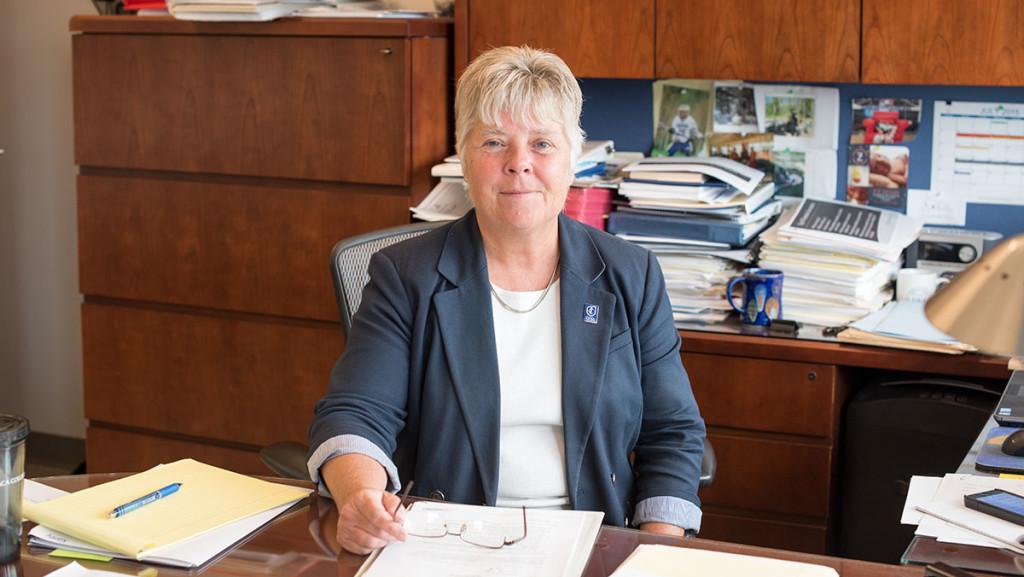Approximately 40 staff positions at Ithaca College will be cut during the current fiscal year.
Nancy Pringle, senior vice president and general counsel for the Division of Human and Legal Resources, announced at the all-college meeting that 47 position lines were cut from the college’s budget in the 2014–15 fiscal year. Thirty-nine of the positions were vacant, while eight were occupied positions, making this the first time the college has eliminated occupied positions since 2009. The college hopes the 40 staff positions to be cut in 2015–16 will primarily be vacant positions, Pringle said.
Pringle said the college began looking at cutting staff positions because of how expensive the college was becoming.
“We were realizing the cost of the Ithaca College education was very costly,” Pringle said. “We were getting to the point where students just couldn’t afford us.”
By cutting 47 positions, the college reduced the compensation budget by $3.1 million.
Pringle and Gerald Hector, vice president of finance and administration, both said the cuts are not due to an economic need.
“This is not driven by finances,” Pringle said. “This is driven by what makes sense for the institution at this point in its history.”
Provost Benjamin Rifkin said three faculty lines were cut this summer as a result of $500,000 being eliminated from the faculty compensation budget in the 2015–16 college budget.
The faculty positions were all unoccupied, and had been empty for the entirety of the 2014–15 school year.
President Tom Rochon said he doesn’t believe the cuts will have an adverse effect on staff morale.
“I can’t imagine that, on the scale of things, a relatively modest program of identifying positions that we don’t need to have students pay for would change a very high commitment to student service on the part of staff,” he said.

Sean Reilley, chair of Staff Council, said staff members are worried about the college making cuts but are grateful for their method.
“While there is definitely some anxiety surrounding the topic of position eliminations, we appreciate the administration’s commitment to recapturing positions that have been vacated through natural attrition as a preferred means of workforce reduction,” he said.
Reilley went on to explain Staff Council’s specific role to represent staff members during cuts.
“In this particular instance, our role will be to relay any questions or concerns our constituents have throughout the process to the appropriate office or administrator,” he said.
In 2015–16, the college’s bottom-line goal is to cut $1.5 million from the staff compensation budget, which will come from cutting 40 positions. The method for identifying where these reductions will come from was outlined by Pringle in four steps.
First, the college will eliminate vacant positions not aligned with the strategic plan.
The second step is to fill vacancies that support the institution’s mission. For example, Lew Durland, former director of energy management and sustainability, who died May 21, will be replaced because his position’s responsibilities are unable to be filled by individuals currently employed by the college.
In the third step, the college will continue to add new positions that support the strategic mission — in 2014–15 the college added five new positions.
Finally, the college will eliminate occupied positions that are not aligned with the strategic plan of the college.
During the 2013–14 fiscal year, the college’s President’s Council, which is made up of Rochon, the vice presidents and the assistant vice president of community and government relations, worked with the Office of Human Resources to identify position lines that could be cut — a process they call strategic workforce analysis.
Hector has spearheaded the college’s efforts to streamline the college’s expenditures through zero-based budgeting, which is a practice in which all expenses must be justified for each new period, and its Strategic Sourcing initiative, which calls for the college to act as a singular buyer of all materials purchased on campus, such as office supplies and furniture.
Yet the college’s compensation costs for faculty and staff still make up the lion’s share of the budget — over $131 million of a total budget of $232.7 million in the 2015–16 fiscal year.
Following the strategic workforce analysis by the President’s Council, the college reached out to senior-level managers in 2014–15 to help identify where cuts could be made. Hector described the workforce analysis completed in 2014–15 as a “bottom-up approach.”
While the college is reducing the size of its workforce, it is not implementing a hiring freeze. A hiring freeze would be implemented if the college were in a weaker place financially, Hector said.
The college also added five positions in the 2014–15 fiscal year — positions that were “aligned with the college’s mission and staffing plan,” Pringle said.
Where are the cuts coming from?
The college will not release a breakdown of which departments the 47 eliminated positions came from during 2014–15.
Pringle said she doesn’t believe students need to know where the cuts are coming from.
“Do I think students should know what the positions are? I don’t,” Pringle said. She also explained that many of the positions were ones that indirectly supported students.
She said if the college did release a position breakdown or names of employees, it might cause “a ground swell of support from students” that these employees don’t want.
Pringle dispelled rumors that cuts were coming largely from facilities and that cuts were coming primarily from lower-level positions.
“They did not come from any one area more than another,” Pringle said. “Those 39 positions cut across all levels, all the way up the very senior management of the institution. Again, because we’re doing it not just to capture dollars; we’re doing it because it makes strategic, good sense for what the workforce should look like.”
Pringle said they currently have an idea of where the cuts will come from in 2015–16, but they could shift.
“We know now where, if we get a vacant position, we need to hold onto positions and where we can redeploy some of the responsibilities,” Pringle said. “There will probably be fewer administrative assistants.”
With the potential to cut occupied positions on the table, the college has adopted a severance plan. The plan includes salary for three to eight months depending on the years of service, medical insurance for severed employees and their family members for up to 1 year, tuition remission for dependents of employees who are currently enrolled for up to 24 months and assistance from human resources in finding a job within or outside the college.
Pringle said this will be the college’s ongoing severance plan for the foreseeable future.
For the departments where cuts have been made, the college will be offering professional development training to other employees to help fill the void made by their absence.
While some staff members may be worried that cuts will result in additional work for remaining staff, Pringle said the college will be asking employees to do things differently in their jobs because of the restructuring of departments that occurs when positions are eliminated.
“We need to give permission to people not to do things, that maybe we’ve done historically,” she said. “That’s going to be hard on both sides. It’s going to be hard for management not to do certain things and it’s going to be hard for the employees to say, ‘What you don’t want me to do X, I’ve always done X.’ It’s trusting that if we don’t do X but we do Y instead, that may be an even better end result for the services were offering students.”
Pringle said she recognizes workforce analysis is complicated and encouraged staff members to speak up if they feel overworked.
“If people who are being impacted by [these cuts] feel like ‘I’m doing way more than one job,’ they need to talk to their supervisor, talk to HR or talk to me,” Pringle said.
Hector said the college is currently looking at a number of information technologies to make the college more efficient and automate some processes that are being done by individuals.
Hector reaffirmed that there are no jobs on campus that are completely safe.
“Everything is up on the table for a discussion or a look-see,” he said.







